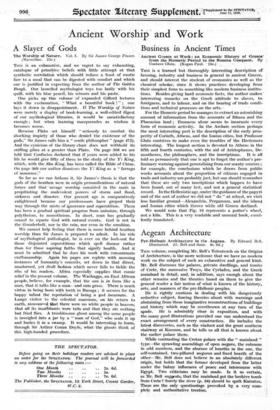Aegean Architecture
THIS volume, completing Mr. Bell's Tetrateuch on the Origins of Architecture, is the more welcome that we have no modern work on the subject of such an exhaustive and general kind. Mr. Bell discusses the palaces, private dwellings, and tombs of Crete, the successive Troys, the Cyclades, and the Greek mainland in detail, and, in addition, says enough about the- other remains and the theories based on them to give the general reader a fair notion of what is known of the history, arts, and manners of the pre-Hellenic peoples.
He is rightly cautious in dealing with his dangerously seductive subject, fencing theories about with warnings and abstaining from those imaginative reconstructions of buildings and history which may be overthrown at any turn of the spade. He is admirably -clear in exposition, and with the many good illustrations provided one can understand the exact arrangement of every construction. He includes the latest discoveries, such as the viaduct and the great southern stairWay at Knossos, and he tells us all that is known about the earlier palace there. While contrasting the Cretan palace with the" mainland" type;---the sprawling assemblage of open megara, the columns in odd numbers, and the absence of hearths in the one, the self-contained, two-pillared megaron and fixed hearth of the other—Mr. Bell does not believe in an absolutely different origin, but holds that the former developed from the latter under the balmy influences of peace and intercourse with Egypt. Two criticisms may be made. Is it so certain, as Mr. Bell suggests, that the mainland got the beehive tomb from Crete ? Surely the river (p. 34) should be spelt Kairatos. These are the only questionings provoked by a very com- plete and authoritative treatise.






















































 Previous page
Previous page